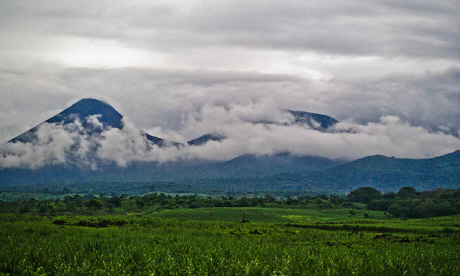
After a history or war, is it time to head back to El Salvador?
In the pockmarked ruins of a bombed-out church, a group of students listened, rapt, as a villager related her experiences of El Salvador’s civil war. Quietly she voiced the memories that many Salvadorans have been trying to forget since the 12-year conflict ended in 1992. Everyone was touched by it, everyone has a story to tell, but not everyone is willing to talk.
Once marketed as ‘the land of smiles’, El Salvador’s tourist industry was devastated by the war, which left around 75,000 dead. But curious travellers are slowly returning. While the government isn’t exactly shouting about turismo alternativo – the small-scale industry surrounding civil war sites – its ambitious strategy aims to attract two million international visitors by 2014. Since his election in 2004, President Tony Saca has established a Ministry of Tourism and a tourist police force, and introduced tax breaks for investors in the industry.
A new logo for the country has the tagline: ‘El Salvador – Impressive!’
With a stricken past, a history of natural disasters and an ongoing crime problem (largely confined to its infamous Mara Salvatrucha gangs), it’s fair to say El Salvador has image issues. But the Salvadorans are an enterprising lot – ‘hardworking’ and ‘hospitable’ are two words often used to describe them – and the country has become an economic powerhouse in Central America, boasting a rebuilt road system, glittering shopping malls and the most modern airport in the region. Yet the contrast between rich and poor is stark – around 30% of the population still lives in poverty.
The main challenge for Central America’s Tom Thumb – the size of Wales, with a population of 6.9 million – is how to distinguish itself from its neighbours, already firmly on the tourist map. El Salvador doesn’t have the eco attractions of Costa Rica, the archaeological big guns of Guatemala or the diving opportunities of Honduras.
But it does have 300km of Pacific coastline, the highest number of active volcanoes in the region, spectacular mountain hiking, sleepy colonial towns and some of the best surfing in the world. Unofficially, war tourism is also recognised as a potential draw.
In Perquín, the revolutionary headquarters during the war, former guerrillas can guide you around old battlegrounds, hideouts and the site of
a notorious massacre.
“El Salvador is special because of its size,” said Cecilia de Moreno of San Salvador-based operator Salvadorean Tours. “It’s so small you can drive across the country in under four hours, so all the attractions are within easy reach. And then there’s the warmth of our people – we’re famous for making visitors feel at home.”
Salvadorans are new to visitors, and still treat them like guests. In a general store in the artsy town of Suchitoto, a shopkeeper wouldn’t let me leave without giving me a pack of the town’s famous hand-rolled cigars. And in La Palma, a town almost exclusively dedicated to arts and crafts inspired by the painter Fernando Llort, artisans eyed me shyly rather than attempting any hard sell.
It’s easy to see the potential of El Salvador’s colonial towns, with their garish murals of civil war icons, shady squares and colourful homes. Pascal Lebailly, who left a career in the Paris fashion industry to open Los Almendros de San Lorenzo, a boutique hotel in Suchitoto, spotted it sooner than most.
“When I arrived here I fell in love at first sight. People say Suchitoto is like Antigua in Guatemala was 20 years ago.” Antigua’s cobblestoned streets are now lined with language schools, coffee shops and hostels – could Suchitoto’s go the same way?
El Salvador may be a fairly new destination for international travellers, but surfers have known its secrets for a while, attracted to its black-sand beaches by world-class waves and warm waters. At Playa El Tunco, a laidback beach community, former surf guide Walter Rieger runs Tekuani Kal, a small hotel.
“In the 1970s there were loads of foreign surfers here but the war stopped that,” he said. “Now the tourist infrastructure is growing again, with hotels, restaurants and cybercafés opening up.”
He’s pragmatic about the issue of crime. “We got the government to install a tourist police station a few feet from our hotel. This country does have its crime problems – but so does everywhere. You kinda have to be in the wrong place at the wrong time.”
Could this be just the right time to visit El Salvador?